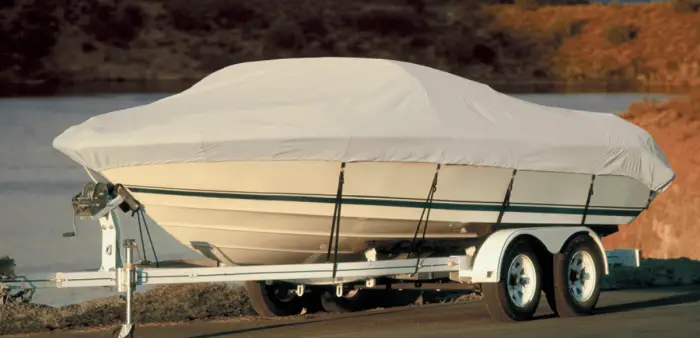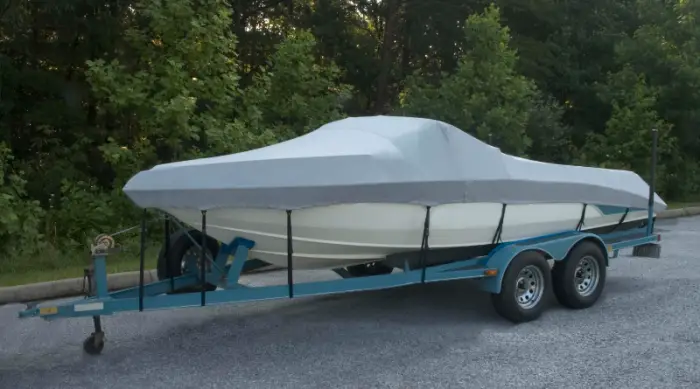
For marine enthusiasts, there’s nothing quite like entering the vast blue expanse of the sea or ocean and getting away from all the hustle and bustle for a few hours. The calming sounds of the waves whooshing past the boat and the sun’s warm rays beaming down on you are just a few of the joys that come from this leisure activity. You’re not overstimulated by your phone or laptop but instead enveloped in the stillness of nature.
But to have a successful boating excursion, you’d have to keep your vessel in prime condition. Not only does it affect the safety of everyone involved, but also the longevity of your investment and its aesthetic appeal. One of the best ways to protect it against fading, sun damage and other environmental elements is by investing in a good quality boat cover.
What Is the Best Material to Cover a Boat?

Some people make the rookie mistake of using any old piece of fabric on top of their vessel, thinking they’re doing the most in terms of affordability and protection. But this doesn’t always provide optimal results in terms of waterproofing and UV resistance, nor does it last very long. With that said, make sure you look for the following options when you’re browsing through the assortment of durable and reliable boat covers available:
Polyester
Starting with what is perhaps the most popular option among boat owners, polyester covers consist of a tightly woven synthetic fabric that’s super lightweight, waterproof and UV-resistant. The tiny weaving spaces between the fibres allow for air circulation, which helps keep your interior cool and dry, all while protecting against fading and other elements.
The reason for this material’s popularity lies in its affordability, as well as its strength and resilience. It doesn’t feel too heavy when putting it on and off your vessel, yet remains highly resistant to tearing or puncturing.
Acrylic
Next up is acrylic, a material that offers the same properties as polyester but with a slightly thicker weave. It certainly has a more luxurious and soft feel to it, which is especially appealing to those who want their vessel’s aesthetic appeal to remain in pristine condition.
This fabric is a tad more expensive, but you’re getting the highest quality of breathability and UV resistance. It has excellent water-repelling properties, helping to keep your interior dry and mildew-free, even in the harshest of environments.
Nylon Blends
Last but not least, nylon blends consist of a woven combination of nylon and polyester. It’s a more affordable alternative to acrylic and has many of the same properties, except for being slightly less breathable than the latter.
Nylon has an inherently stable and strong structure, with the ability to stretch and rebound when in contact with water. It’s highly resistant to tearing and abrasions, thanks to its intricate weaving pattern, and also has excellent durability in terms of protecting against the sun’s rays.
What Type of Boat Cover Do You Need?

In addition to the material specifications, you need to look into other aspects that make up the construction of today’s boat covers to fully reap its benefits. Sometimes, even the best-quality polyester or acrylic won’t provide the level of protection you need if it doesn’t have certain features.
Thickness
This goes hand in hand with the weight of the fabric, as you’d want a thicker material to provide more coverage and better protection against the elements. This doesn’t necessarily mean it has to be too heavy, as manufacturers are now offering lightweight fabrics with a higher gauge and weight rating.
The key is to strike a balance between the two, as you don’t want a cover that’s too thin and prone to tearing but also one that’s too cumbersome. A solid middle ground would be to find a material with an adequate thickness and weight to ensure more longevity for your investment.
For instance, an average cover should fall within the 150-200 g range, regardless of the type of material used. Anything lighter than this is not recommended, as it won’t last as long and won’t provide the best protection.
Breathability
This is certainly an underrated feature, but it’s just as significant as the rest. Breathability refers to the amount of air circulation between the material and your boat’s interior, to prevent moisture build-up and mildew.
Even though you’re covering your vessel, you don’t want it to be completely airtight. Without proper breathability, the fabric will trap moisture and eventually cause it to rot and weaken.
With that said, you need to ensure adequate airflow to facilitate a healthy environment. Most of today’s covers are designed with this in mind, as they feature small perforations or holes that allow air to freely circulate and keep your boat dry. In terms of materials, nylon blends and acrylics are the most breathable fabrics out there.
Fit and Measurements
No matter how good your material is or how breathable it is, your cover won’t serve its purpose if it doesn’t fit properly. If it has too much slack, it won’t provide enough coverage. The same can be said for covers that are too snug, as this will cause unnecessary tension and wear and tear on the fabric.
As such, you want to make sure that the cover is tailored to your vessel’s specific measurements. Take into account the length, width and height of the vessel, as well as any other protruding parts, such as rails or outboard motors. You might need a custom-made model to get the job done, as standard sizes might not offer enough coverage.
Cleaning and Maintenance

The cleaning process for boat covers will depend on the material used. Polyester and acrylic require a mild cleaning solution to prevent damage, while you can safely chuck the nylon cover into the washing machine without any problems.
For all materials, it’s best to use a gentle cycle and never chlorine bleach or any other strong detergents, as these can weaken and damage the fabric. Once you’re done, make sure to dry it out completely before storing it away.
Additional Design Features
Finally, if you don’t want to settle for a basic model, there are plenty of additional design features to look into. They can be as simple as reinforced seams and additional straps or loops, or they can include more advanced designs such as pockets that allow you to store items underneath the cover.
The former two are particularly crucial for added strength and durability, as they will keep the material from ripping and fraying in areas that receive the most tension. On the other hand, pockets and compartments can be useful for storing items during transportation or when you’re taking a break from sailing.
